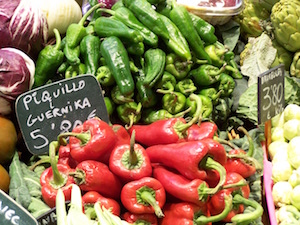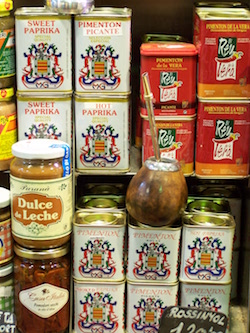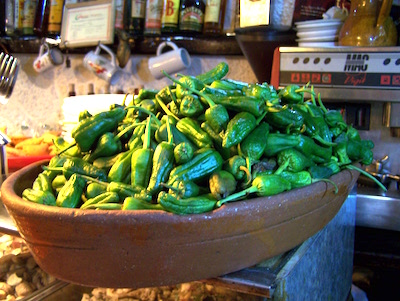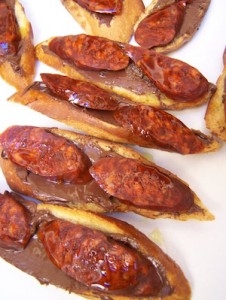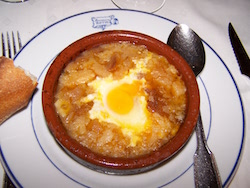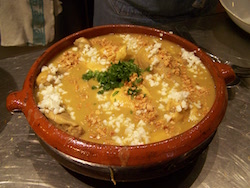Article and Photos By Sharon Hudgins
“We use many spices in Spanish cooking,” said Gabriela Llamas, a noted cookbook author and cooking school owner in Madrid, as she prepared to teach a class on Spanish regional cuisines.
“Remember that when Columbus discovered the New World, he wasn’t looking for a new world, he was looking for the Spice Route to Asia,” she added. “And later the Dutch and British fought wars over access to those spices in Asia. A boat full of nutmeg was worth as much as a boat full of gold.”
Lined up on Gabriela’s table were bowls of saffron, cinnamon, cloves, paprika, salt, black pepper, bay leaves, and fresh garlic, all of which soon found their way into brightly colored, subtly spiced dishes from Extremadura in the western part of Spain, the Basque country in the north, and Valencia on the Mediterranean coast.
A Spicy History
Most of the spices used in Spanish cooking today came to Spain over several centuries, from distant lands and by many routes. Black pepper and cloves from Asia were probably used by the Romans who ruled much of Spain from approximately 200 BC until 400 AD. Beginning in 711 AD, invading armies of Arabs and Berbers (collectively called “Moors”) from North Africa swept up into the Iberian Peninsula, soon conquering most of the territory of Spain. During nearly 800 years of Moorish rule in various regions of the country, Arab merchants and horticulturalists introduced many herbs and spices, including mint, coriander, cinnamon, and cumin. And by the 16th century, allspice, vanilla, and Capsicum peppers (including fiery-hot chiles) from the Western Hemisphere were added to the repertoire of ingredients available to Spanish cooks.
In 1492 Christopher Columbus sailed from the Spanish port of Palos de la Frontera on his first voyage in search of a westward sea route to the spice-producing lands of Asia. Instead, he bumped into some islands of the Western Hemisphere, an accident of navigation that changed the history of the world–including its culinary history. Capsicum peppers were among the many new plants that Columbus brought back to Spain from his four journeys to the “New World” he had inadvertently found. And as early as 1493, these peppers were being grown in Spain, at first only as ornamental plants, but soon for use in cooking, too.
When Columbus first encountered pungent-tasting peppers in the Caribbean islands, he called them pimientos, a derivative of the Spanish word for “pepper” (pimienta), the completely different spice he was actually seeking in Asia. That’s why today all Capsicum peppers in Spain–from large to small, mild to hot–are called generically pimientos, whereas pepper spice from Asia is pimienta negra (black pepper), pimienta blanca (white pepper), pimienta en grano (peppercorns), or pimienta molida (ground pepper, black or white). Small, hot, dried red Capsicum peppers are sometimes also referred to as chilis, after the Nahuatl (Mexican) term used for the pungent pods on the other side of the Atlantic Ocean.
Spanish Paprika
When ripe-red Capsicum peppers are dried and milled into powder in Spain, the resulting product is the distinctive paprika spice known as pimenton. The Spanish produce three basic types of pimenton: dulce, mild or “sweet,” with a rich, even meaty flavor; agricdulce, “bittersweet,” with a rich, meaty flavor and sometimes a hint or “bite” of sourness, often followed by a hot-spicy aftertaste; and picante, truly hot-spicy paprika, used more sparingly in Spanish cooking. Although dulce paprikas are the most common in Spain, agridulces and picantes have a distinct role in spicing up the cuisine.
In 1893, when the Spanish gastronome Angel Muro published his first edition of El Practicon–Spain’s nineteenth-century equivalent of the Joy of Cooking–he referred to both sweet and hot pimentón. Muro claimed that paprika had “become, for almost all the inhabitants of Spain, but primarily for those of [the region of] Old Castile, an article of prime necessity, like salt and vinegar.” He went on to say that in Old Castile “not a single food is put on the table that is not seasoned with sweet or hot paprika.” He also pointed out that large amounts of paprika were consumed in the region of Extremadura, not only as an ingredient in cooked dishes, but also as an element in preserving the many types of chorizos (pork sausages) produced in that part of Spain.
Today, Extremadura is one of the major paprika-producing regions of Spain, along with Leon, Murcia, and Catalonia. Pimentón de La Vera–smoked paprika from La Vera region of Extremadura–was the first paprika to earn a Denominacíon de Origen designation, or “protected name status,” in Spain, ensuring that only the special paprika produced there could bear that title. This distinctive type of paprika from Extremadura is made by smoking a variety of ripe red peppers (depending on the type of paprika desired) over smoldering embers of holm oak for 10 to 15 days before the peppers are ground into powder. Unsmoked pimentón, from Murcia and other regions of Spain, is made from peppers that have been dried in the sun (the artisanal method) or over hot air from electric heaters in large-scale commercial paprika factories.
Nearly 80 percent of all the pimentón produced in Spain goes into making the many kinds of deep-red chorizo sausages for which the country is also famous. The remainder is used in cooking a wide range of dishes, from tasty tapas to hearty fish soups and meat stews. And a small amount of pimentón is exported to other countries, as more and more people outside of Spain are discovering the distinctive flavor of Spanish paprika, which is different from the other well known paprikas produced in places like Hungary and the United States. (See “Sources” sidebar.)
Pimientos de Padrón
The Spanish do not have timid tongues. Despite their preference for mild fresh peppers and sweet paprikas, many Spaniards enjoy eating hot-spicy foods, too. One or two dried hot peppers are often dropped into a soup or stew, in the same way that salt and black pepper would be added. Certain innocent-looking, but highly spiced, sauces can surprise the unsuspecting palate. And a favorite tapa in many Spanish bars is pimientos de Padrón–a plate of fresh whole green peppers from the region of Galicia, which are quickly fried in olive oil, then sprinkled with coarse sea salt. As the bartender will warn you, “Unos pican y otros non“–“some are hot and the others are not”–but until you bite into them, you don’t know which of those little green peppers is going to blow your taste buds away. Enjoy!
Sharon Hudgins is the author of an award-winning cookbook, Spain: The Cuisine, the Land, the People (Spanien: Kuche, Land und Menschen, published by Hadecke Verlag in Germany, 1991). She has lived in Spain and has eaten her way through all 47 provinces on the Spanish mainland.
SOURCES OF SPANISH INGREDIENTS
The Spanish Table
(stores in Seattle, WA; Santa Fe, NM; Berkeley, CA; and Mill Valley, CA; online at www.spanishtable.com)
From Spain
Ole Ole
La Tienda
Yaya Imports
Recipes
Spanish Spicy Olives (Aceitunas Alinadas)
I recently ate these as a tapa at a cerveceria (beer tavern) in Barcelona, where they were a great accompaniment to mugs of Spanish beer, fresh from the barrel. Of course the saltiness makes you want to drink more beer–but what’s wrong with that?
1 pound Spanish green olives, unpitted
1/2 to 3/4 cup small pickled pearl onions
1/2 cup diced bottled roasted red Spanish peppers (mild)1/4 to 1/2 cup chopped pickled green peppers (Spanish pickled green guindillas or Italian pepperoncini)
1 tablespoon pickled capers
1 tablespoon Spanish olive oil
1/2 teaspoon hot Spanish paprika (smoked or unsmoked)
1/4 teaspoon ground cumin
First, under warm running water, rinse the olives, pearl onions, pickled green peppers, and pickled peppers to reduce their saltiness. Drain them thoroughly.
Combine all the ingredients in a medium-size bowl. Cover and refrigerate for at least 24 hours, to let the flavors meld. Serve at room temperature, as a tapa to accompany dry Spanish sherry, white or red Spanish wine, or Spanish beer.
Yield: About 2-1/2 cups
Heat Scale: Mild to medium
Chocolate-Chorizo Tostadas
(Tostadas de Nutella y Chorizo)
This surprising appetizer was created by Jason Dady, chef at The Lodge Restaurant of Castle Hills in San Antonio, Texas and Bin 555 Restaurant and Wine Bar in Dallas and San Antonio. Dady combined New World flavors of chiles, chocolate and vanilla with Spanish olive oil and traditional Spanish chorizo pork sausages (flavored with Spanish paprika) to make an appetizer that appeals to the child in every adult. The combination of chocolate and chiles is reminiscent of traditional Mexican mole poblano.
Country-style French bread, cut crosswise into 1/2-inch thick slices
Spanish extra-virgin olive oil
Nutella chocolate-hazelnut spread
Vanilla-bean-flavored sea salt (see NOTE), or unflavored sea salt
Spanish hard chorizo sausage (not Mexican soft chorizo sausage), cut crosswise into 1/8-inch-thick slices
Toast the bread slices on both sides and let them cool. Lightly brush one side of each bread slice with olive oil, then spread a thin layer of Nutella on top (like spreading mayonnaise on sandwich bread). Sprinkle a small amount (a pinch or two) of sea salt evenly over the Nutella, then place two or three slices of Spanish chorizo in a single layer on top. Serve at room temperature, as an appetizer or snack, accompanied by a robust Spanish red wine from the Rioja region.
NOTE: Make vanilla-scented sea salt by finely crushing a vanilla bean and combining it with sea salt (preferably fleur de sel) in a tightly covered glass container. Let the mixture stand for several days, at room temperature, for the flavors to meld.
Yield: Variable
Heat scale: Mild
Andalusian Baked Eggs, Flamenco-Style
(Huevos a la Flamenca)
This recipe comes from Sevilla, a city famous for its flamenco music–and the dish is as colorful (and saucy) as a female flamenco dancer. In Spain, it’s traditionally cooked and served in little individual earthenware casseroles. The garnishes on top of the eggs can be varied to use up any bits and pieces of leftover meats and vegetables in your kitchen.
6 tablespoons Spanish olive oil (plus oil for the casseroles)
1 large onion, finely chopped
3 large garlic cloves, minced
1 1/2 cups diced cooked ham (divided use)
1 tablespoon mild/sweet Spanish paprika (smoked or unsmoked)
6 large tomatoes (fresh or canned), peeled, seeded, and chopped
3/4 cup chicken stock
Salt
Freshly ground black pepper
12 eggs
12 cooked green asparagus stalks
2 whole canned Spanish pimientos, cut lengthwise into 12 strips
6 cooked artichoke hearts, cut into halves or quarters
12 slices hard Spanish chorizo sausage (not soft Mexican chorizo)
3/4 cup cooked green peas
Preheat the oven to 450 degrees F. Lightly oil the insides of six 1-1/2-cup individual shallow earthenware casseroles or ovenproof ramekins.
Heat the olive oil in a large skillet, and saute the onion, garlic, and half the diced ham until the onion is soft. Sprinkle in the paprika and cook, stirring constantly for 30 seconds. Immediately stir in the tomatoes and chicken stock. Cook uncovered over medium heat, stirring occasionally, for 15 to 20 minutes, or until the liquid is reduced and the sauce is thick. Taste and add salt and pepper as needed.
Divide the sauce among the 6 casseroles, spreading it in an even layer. Carefully break 2 eggs over the sauce in each casserole. Arrange the asparagus, pimiento strips, artichoke hearts, chorizo slices, green peas, and remaining half of the diced ham decoratively around and over the raw eggs in each casserole. Sprinkle lightly with salt and pepper.
Bake the casseroles in the preheated oven for about 8 to 10 minutes, until the egg whites have set but the yolks are still runny. Serve immediately, as a first course or as the main dish of a light meal, accompanied by a crisp green salad dressed with Spanish olive oil and coarse salt.
Yield: 6 servings
Heat scale: Mild
Spanish Garlic Soup (Sopa de Ajo)
This peasant soup is popular throughout Spain where it’s known by many names, including simple sopa de ajo (garlic soup), sopa castellana (Castillian soup), and sopa de ajo leonesa (garlic soup from Leon). Sometimes the egg is stirred into the soup, like Chinese egg-drop soup, instead of baked on top–or even omitted entirely. The use of ham is also optional, but personally I think it adds another deeply Spanish layer of flavor.
Preheat the oven to 450 degrees F. Heat 1/4 cup of the olive oil in a large skillet over medium heat, and fry the bread slices in it, cooking them on both sides. Put 1 slice of fried bread into each of 4 ovenproof soup bowls. (In Spain, this soup is often served in straight-sided earthenware bowls, glazed only on the inside.)Heat the remaining 1/4 cup of olive oil in a large heavy saucepan over medium heat. Add the garlic and cook, stirring constantly, for 2 to 3 minutes, until the garlic is soft but not browned. Add the diced ham and sauté for 2 to 3 minutes longer.Remove the pan from the heat and stir in the paprika. Mix well. Place the pan over low heat and cook, stirring constantly, for 1 minute. Do not let the paprika burn! Immediately add the chicken stock (or water) and salt. Bring to a boil over medium heat, then reduce the heat and simmer, uncovered, stirring occasionally, for 10 minutes. Taste and add more salt if desired.Place the soup bowls on a baking sheet. Pour the hot soup over the bread in each bowl. Break 1 egg onto a saucer, and slide the raw egg carefully onto the top of the soup in 1 bowl. Repeat for each of the remaining bowls. Put the baking sheet with the soup bowls into the hot oven for 3 to 4 minutes, or until the eggs have baked and set. (Usually this dish is baked only until the whites have set and the yolk is hot, but still a bit runny.) Serve hot.
Zarzuela (sarsuela in the Catalan language) is a musical term for a type of Spanish operetta–a colorful, witty mixture of song, dance, and theater. The same term is also used for this colorful, flavorful Catalan dish that combines several types of seafood with sweet red peppers and almonds.
1/8 teaspoon finely crumbled saffron threads
1 tablespoon Spanish sherry
1/2 cup Spanish olive oil
2 large onions, coarsely chopped
4 to 5 large garlic cloves, minced
2 tablespoons finely chopped Spanish jamon serrano (dry-cured raw ham)
1 tablespoon mild/sweet Spanish paprika (unsmoked)
1 tablespoon hot Spanish paprika (unsmoked)
1/2 cup blanched almonds ground in a nut grinder or blender
6 medium tomatoes (fresh or canned), coarsely chopped
2 red bell peppers, seeded, deveined, and cut lengthwise into 1/4-inch-wide strips
1 bay leaf, finely crumbled
1/2 cup dry white wine
Juice of 1 lemon
1-1/2 pounds fish filets (sole, turbot, perch or red snapper), cut into 2-inch chunks
1 pound whole shrimp, in the shell, washed and drained
Garnish:
3 tablespoons chopped fresh parsley
6 lemon wedges
Mix the crumbled saffron threads with the sherry in a small bowl, and set aside for them to steep while you assemble the rest of the dish.
Heat the olive oil over medium heat in a large (4-quart) heavy-bottomed stovetop casserole. When the oil is hot, sauté the chopped onions until they begin to soften. Add the garlic and ham and sauté them with the onions until the onions are very soft. Sprinkle the paprika over this mixture, stir well, and cook over very low heat, stirring constantly for 2 minutes. Add the ground almonds and cook, stirring constantly, for 1 minute. Stir in the tomatoes, red bell peppers, bay leaf, and saffron with the sherry it steeped in. Increase the heat to medium and let the mixture cook uncovered for 5 minutes.
Stir in the white wine and lemon juice. Add the pieces of fish. Bring the mixture to a boil, reduce the heat to low, and simmer uncovered for 10 minutes. Add the unpeeled shrimp, stir gently to combine with the other ingredients, and simmer for another 3 to 4 minutes (maximum–otherwise the shrimp will be tough). Serve immediately, in shallow soup bowls, garnished with chopped fresh parsley and lemon wedges. Or serve on plates with plain boiled rice and a green salad on the side. Dry white Catalan wine goes especially well with this dish.
Yield: 6 large servings
Heat scale: Mild to medium






